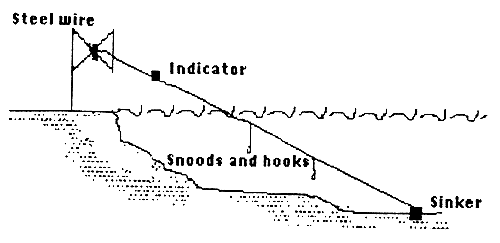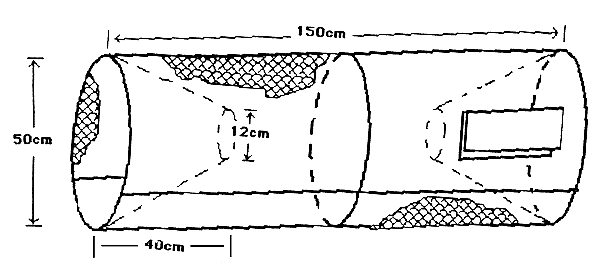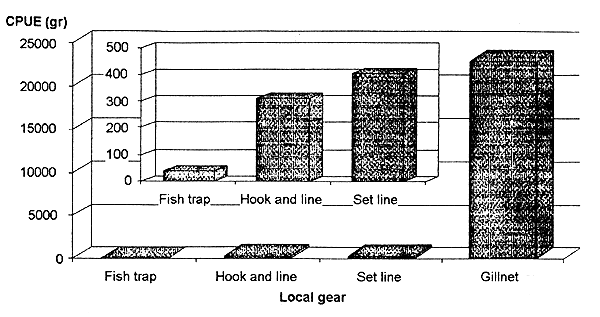One of the project's activities was to evaluate various types of fishing gear with a view to assessing their efficiency for subsistence, commercial and scientific sampling purposes. No single item of fishing gear is ideal and universally applicable for all purposes. Gears differ in their effectiveness for capturing various species and size of fish.
For commercial fishery, the most cost-effective gear for taking the desired species in the required size-range will usually be chosen. This requires the use of several different types of fishing gear, and a detailed knowledge of the selective properties of each.
For subsistence fishery, there is need to identify local gears which have low capital requirements or are easy to make with locally available material.
Low outputs with handling compared to high catches from preliminary gillnet test fishing (chapter 5) indicate that the fish stock is presently under-exploited in lowland reservoirs.
With the use of gillnets, longlines and fish traps, fishermen could catch more fish than with hook and line. Greater quantities of fish could be caught and fishery resources would be utilized optimally. Particular exercises on handline fishing techniques were emphasized to determine whether catches coming from the subsistence fishery could be improved.
Seine nets could not be tested since most of the lowland reservoirs were observed to hold numerous submerged obstacles (Tilquin & Maseatile, 1994). Evaluation of such material needs a preliminary rigorous area and reservoir selection so as not to damage nets.
Four species which occur in lowland dams are attractive to anglers. The most important of these is the common carp which favours the very shallow inshore areas. Smallmouth yellowfish is known as an excellent fighter but catch could be affected by the high turbidity since this fish visually selects its baits. This is not the case for the catfish which detects its food by taste and prey movement through its sensitive barbels. A fourth potential species is the Orange River labeo.
The four fishing gear tested in this exercise - gillnet, setlines (floating and bottom), hook and line and fish trap - are passive. They do not have to be dragged or towed to capture fish. The catch is recovered by simply removing the gear from the water after a period of time. Fishing gear terminology used hereafter is from Nedelec & Prado (1990) and von Brandt (1984).
Multifilament monomesh gillnets were proposed. Two mesh sizes, 73mm and 93mm, were chosen since they were found to be the most efficient for capture of fish during preliminary fish test fishing undertaken in Lesotho Lowland reservoirs (Mofolo et al, 1993). They are 3m high and about 30m long. The total area of the nets is 90m2. The nylon twine is similar to the one used for fish stock assessment (Chapter 5).
The use of set lines can increase the number of lines deployed without requiring the constant presence of the fisherman. Investigations have found that the efficiency of the longlines is influenced not only by the design of the hook and the type, size and shape of the bait, but also by the material, length and spacing of the traces (von Brand, 1984).
The floating long line proposed has a total length of 28m. It comprises a 0.7mm main line to which traces (also called snood or branch line) with baited hooks are fixed at regular intervals of 2m. Traces (Æ=0.27mm) are 0.30m long (Figure 8.1.).
Traces are connected to hooks, Mustad No8 (Figure 8.2) and main line with swivels which have the benefit of eliminating entanglement and so reduce the labour of gear handling. The main line is set on the surface by means of floats spaced at 7m apart and two weights at each end.
Figure 8.1. Floating longline.

Figure 8.2. Hook size terminology. (Break hook; scale 1:2.5)

The main line has a total length of 28m to which traces with baited hooks are fixed at regular intervals of 2m. Traces were 0.5m long and heavier (diameter=0.42mm; breaking strain of 9.08kg) than the ones used for making the “floating” longline type. The target species for bottom longlines in Lesotho is Clarias gariepinus.
Due to severe erosion occurring in Lesotho, large amounts of soil are being trapped in reservoirs. We therefore propose to hold bottom lines off the muddy bottom by floats (Figure 8.3), as recommended by von Brandt (1984).
The main line is set at the bottom with two heavy weights, tied at each end.
Figure 8.3. Near-bottom longline.

The simplest form of fishing requiring only a line and a baited hook is inexpensive and easy. Almost any boat or shoreline can be used and the catch is live and of high quality. In spite of these advantages, line fishing is labour intensive. A 1xmited number of fish can be captured per line. Line fishing methods can be made more efficient if multiple hooks are used on a line.
What is commonly done by local subsistence fishermen is that, a short piece of steel or aluminium wire is stuck into the ground, to which the fishing line is attached (Figure 8.4.). Two hooks are knotted to the line with a swivel, as well as a sinker. Two lines are mounted with Mustad No 6 hooks, and one with Mustad No 8 hooks. The 0.37mm monofilament line used is 50m long. Hook and line were respectively slightly smaller and thinner than the ones used by local fishermen.

Traps are devices that fish or shellfish enter into in search of shelter or food, or because an obstacle is placed in the normal path of migration of the fish. They are designed so that getting out is harder than getting in. Traditional techniques employing traps and pots have been developed in all regions of the world to catch demersal species. Their design and operation match the specific conditions and behaviour of fish in a given area. Hence the importance of local knowledge in design and placement cannot be overemphasized (Botsid, 1988).
The fish pot type proposed is made of a wire frame covered with small mesh net as demonstrated on Figure 8.5. The shapes proposed are from a prototype made in Zimbabwe, as traps have never been used by any Basotho fishermen.
Figure 8.5. Fish pot (from Nedelec, 1975).

Three replicas of each gear described above were made. Three tests were carried out setting fish traps, floating longlines, gillnets and hooks and lines during October and November 1993. However, only two monomesh gillnets (73 and 93mm mesh size) were set per test since numerous fish were caught. Bottom longline te+w fishing was proposed to be tested in a separate exercise since the target species are different from the other gear.
Gear were set in the 0–3m depth zone just before sunset (16–17h00) and lifted (7–8h00) just after sunrise. Handline fishing was carried out during the day for a 5 hour period during mornings of the days when the other gear were set.
A mixture of mealie-meal mixed with bread flour was prepared as bait to attract fish. Other ingredients were added in the particular exercise on improved handline fishing (pt.8.3.2.).
Longlines were wrapped around open side plastic baskets and hold up by a polystyrene rim fitted around such baskets. Hooks, hung on the rim, were baited in the boat before setting lines.
Catch per unit effort (CPUE) was calculated as the total weight (in gr.) of all fish caught per gear (one replicate) per night (15hrs). Handline catches have been multiplied by 3 since one effort represents a five-hour fishing period.
As mentioned in the introduction to this chapter, catches from local fishermen are known to be poor. The purpose of this particular exercise is to verify estimates coming from the creel survey (Chap.6) and to propose locally available equipment which should improve the subsistence fishery efficiently.
The method was similar to the handline fishing suggested in the comparison of local gear. The first part of the test utilized improved equipment. Materials were mounted as shown in Figure 8.4. One nylon twine is fitted with two hooks. However lighter lines and smaller hooks were examined. Nylon twine ranged from 0.12 to 27 mm, and hooks, Mustad from No 8 to No 12, were proposed.
Afterwards, a control test was implemented using material similar to that commonly used by Basotho fishermen. Nylon twine of 0.42mm and hooks, Mustad, No 1/0 and 2/0 were tested.
Catch per unit effort (CPUE) was calculated as the total weight (in g) of all fish caught by one line in 12 hours, but results were inconclusive because of problems in implementating the trials.
Results from three comparative test fishing exercises undertaken in Maqalika dam in November 1993 are presented on Figure 8.6. CPUE is the fish weight (in g.) per gear per fishing effort (15 hrs).

The gillnet catches are out of proportion to the other local gear tried in this present exercise. The CPUE for the three tests is above 20kg for gillnet; meanwhile the CPUE for handline is about 0.8kg and for longline about 0.4kg. Catches of this latter gear are poor, specially if we consider also the time consumed to bait hooks, and to handle and set the line.
Fish trap catches in term of weight were low since only fingerlings from 25 to 40 gr. were caught. If we consider the number of fish caught, results are relatively superior to the handline or setline fishing.
Because of time constraints, near-bottom long-lines have not yet been properly tested. However, Allanson & Jackson (1983) produced interesting data on bottom long line fishing in the Lake Leroux (South African Highveld). 28 lines mounted with 25 hooks, Mustad No 6, tied 1,5m apart, were set 4 times per annum (April/July/October/January) from April 1979 to January 1982. Mean CPUE per line was positive, 7–8kg in weight and 1.8 in number. These encouraging results show that the bottom long line should be tested also in Lesotho lowland reservoirs.
12 test fishing trials with improved equipment were undertaken in October & November 1993 and 5 control trials in February 1994.
We saw that using thinner line and smaller hook can bring catches up. Bait effect also occurs. New ingredients mixed with the standard bait (mealie-meal mixed with water and bread flour) have improved catches. A variety of bait ingredients could be used ranging from potatoes, eggs and spices to artificial flavours. But these results have to be viewed carefully because the experiments carried out were too variable.
The comparison of gear effort shows that gillnets are currently the most appropriate gear for commercial fishing. Catch from floating longlines for cyprinid is poor and handling is time consuming. The proposed standard model of fish pot traps only fingerlings even if we considerably increase the size proportion of the trap to reach an inlet of 12cm. This latter model should therefore be avoided in fisheries in Lesotho.
Handline fishing offers interesting potential for both subsistence and recreational fisheries. The test on improved hook and line fishing confirms this statement.
Most of the fishermen were seen fishing with inappropriate hooks and lines. It is usually believed that bigger fish can be caught with larger hooks and baits. The main target species (common carp, Labeo and Barbus spp.) for handline fishing belong to the cyprinid family and are bottom feeders (see chap.5.3.). They should be supported by an different strategy. Even large fish will swallow relatively small baits. Hook sizes from No 8 to No 10 (Figure 8.2.) should be suitable for catching large common carp (750–3,000gr). The catch count will depend on fishermens skills once appropriate material is used.
Fishing with three lines, two for cyprinid and one for catfish, would be an interesting method in order to cover all species which could be caught from the shoreline in lowlands reservoirs.